dashboard warning lights FIAT CROMA 2006 2.G Owners Manual
[x] Cancel search | Manufacturer: FIAT, Model Year: 2006, Model line: CROMA, Model: FIAT CROMA 2006 2.GPages: 240, PDF Size: 7.41 MB
Page 104 of 240
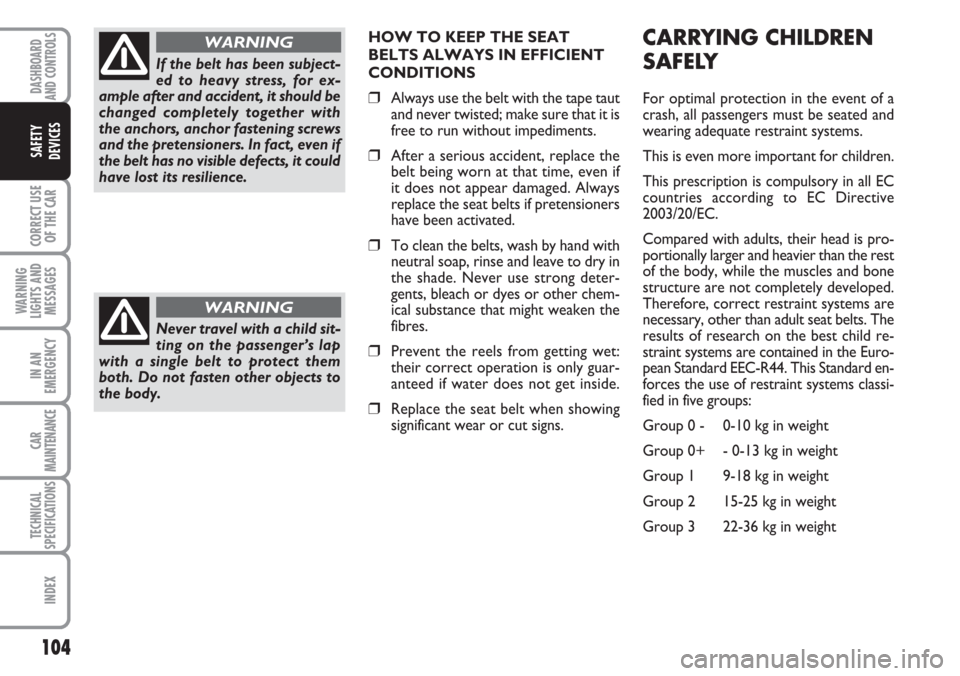
104
CORRECT USE
OF THE CAR
WARNING
LIGHTS AND
MESSAGES
IN AN
EMERGENCY
CAR
MAINTENANCE
TECHNICAL
SPECIFICATIONS
INDEX
DASHBOARD
AND CONTROLS
SAFETY
DEVICES
HOW TO KEEP THE SEAT
BELTS ALWAYS IN EFFICIENT
CONDITIONS
❒Always use the belt with the tape taut
and never twisted; make sure that it is
free to run without impediments.
❒After a serious accident, replace the
belt being worn at that time, even if
it does not appear damaged. Always
replace the seat belts if pretensioners
have been activated.
❒To clean the belts, wash by hand with
neutral soap, rinse and leave to dry in
the shade. Never use strong deter-
gents, bleach or dyes or other chem-
ical substance that might weaken the
fibres.
❒Prevent the reels from getting wet:
their correct operation is only guar-
anteed if water does not get inside.
❒Replace the seat belt when showing
significant wear or cut signs.
CARRYING CHILDREN
SAFELY
For optimal protection in the event of a
crash, all passengers must be seated and
wearing adequate restraint systems.
This is even more important for children.
This prescription is compulsory in all EC
countries according to EC Directive
2003/20/EC.
Compared with adults, their head is pro-
portionally larger and heavier than the rest
of the body, while the muscles and bone
structure are not completely developed.
Therefore, correct restraint systems are
necessary, other than adult seat belts. The
results of research on the best child re-
straint systems are contained in the Euro-
pean Standard EEC-R44. This Standard en-
forces the use of restraint systems classi-
fied in five groups:
Group 0 - 0-10 kg in weight
Group 0+ - 0-13 kg in weight
Group 1 9-18 kg in weight
Group 2 15-25 kg in weight
Group 3 22-36 kg in weight
If the belt has been subject-
ed to heavy stress, for ex-
ample after and accident, it should be
changed completely together with
the anchors, anchor fastening screws
and the pretensioners. In fact, even if
the belt has no visible defects, it could
have lost its resilience.
WARNING
Never travel with a child sit-
ting on the passenger’s lap
with a single belt to protect them
both. Do not fasten other objects to
the body.
WARNING
Page 105 of 240
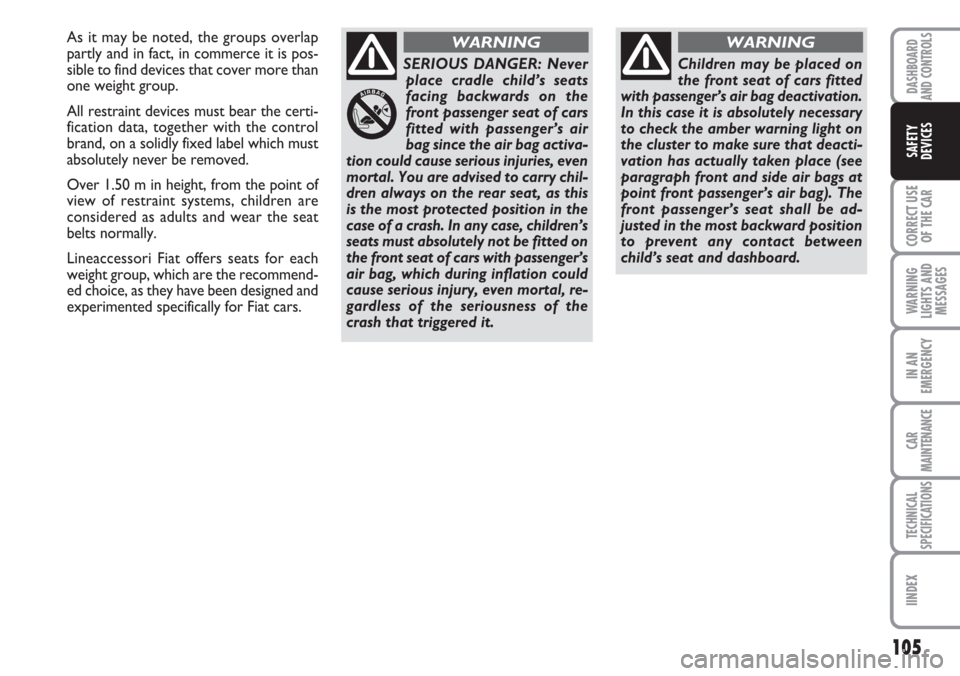
105
CORRECT USE
OF THE CAR
WARNING
LIGHTS AND
MESSAGES
IN AN
EMERGENCY
CAR
MAINTENANCE
TECHNICAL
SPECIFICATIONS
IINDEX
DASHBOARD
AND CONTROLS
SAFETY
DEVICES
As it may be noted, the groups overlap
partly and in fact, in commerce it is pos-
sible to find devices that cover more than
one weight group.
All restraint devices must bear the certi-
fication data, together with the control
brand, on a solidly fixed label which must
absolutely never be removed.
Over 1.50 m in height, from the point of
view of restraint systems, children are
considered as adults and wear the seat
belts normally.
Lineaccessori Fiat offers seats for each
weight group, which are the recommend-
ed choice, as they have been designed and
experimented specifically for Fiat cars.
SERIOUS DANGER: Never
place cradle child’s seats
facing backwards on the
front passenger seat of cars
fitted with passenger’s air
bag since the air bag activa-
tion could cause serious injuries, even
mortal. You are advised to carry chil-
dren always on the rear seat, as this
is the most protected position in the
case of a crash. In any case, children’s
seats must absolutely not be fitted on
the front seat of cars with passenger’s
air bag, which during inflation could
cause serious injury, even mortal, re-
gardless of the seriousness of the
crash that triggered it.
WARNING
Children may be placed on
the front seat of cars fitted
with passenger’s air bag deactivation.
In this case it is absolutely necessary
to check the amber warning light on
the cluster to make sure that deacti-
vation has actually taken place (see
paragraph front and side air bags at
point front passenger’s air bag). The
front passenger’s seat shall be ad-
justed in the most backward position
to prevent any contact between
child’s seat and dashboard.
WARNING
Page 106 of 240
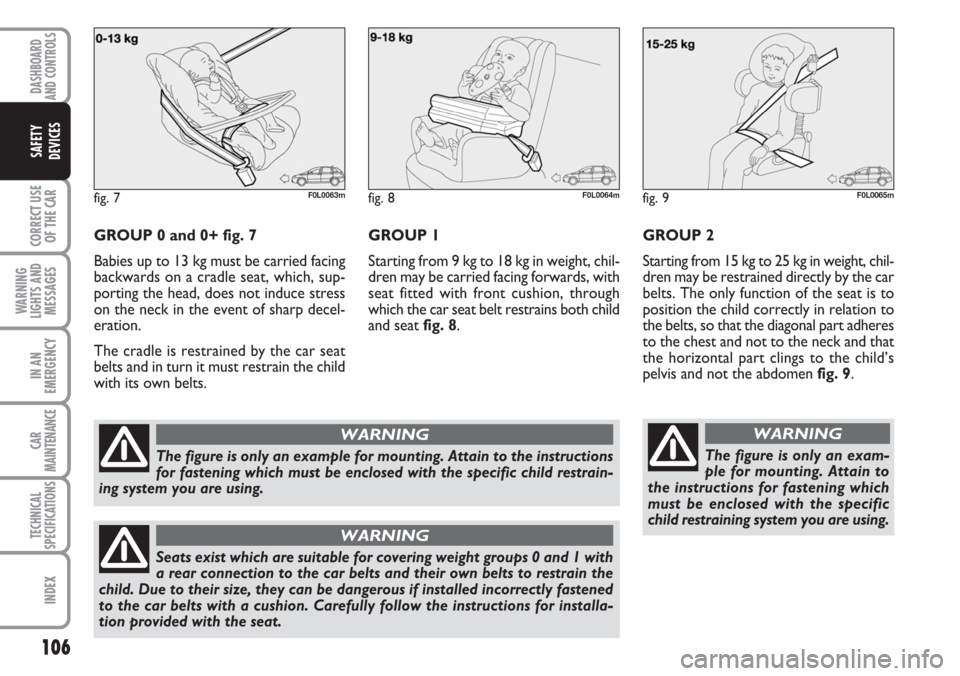
106
CORRECT USE
OF THE CAR
WARNING
LIGHTS AND
MESSAGES
IN AN
EMERGENCY
CAR
MAINTENANCE
TECHNICAL
SPECIFICATIONS
INDEX
DASHBOARD
AND CONTROLS
SAFETY
DEVICES
GROUP 0 and 0+ fig. 7
Babies up to 13 kg must be carried facing
backwards on a cradle seat, which, sup-
porting the head, does not induce stress
on the neck in the event of sharp decel-
eration.
The cradle is restrained by the car seat
belts and in turn it must restrain the child
with its own belts.GROUP 2
Starting from 15 kg to 25 kg in weight, chil-
dren may be restrained directly by the car
belts. The only function of the seat is to
position the child correctly in relation to
the belts, so that the diagonal part adheres
to the chest and not to the neck and that
the horizontal part clings to the child’s
pelvis and not the abdomen fig. 9.
fig. 7F0L0063m
The figure is only an example for mounting. Attain to the instructions
for fastening which must be enclosed with the specific child restrain-
ing system you are using.
WARNING
Seats exist which are suitable for covering weight groups 0 and 1 with
a rear connection to the car belts and their own belts to restrain the
child. Due to their size, they can be dangerous if installed incorrectly fastened
to the car belts with a cushion. Carefully follow the instructions for installa-
tion provided with the seat.
WARNING
fig. 8F0L0064m
GROUP 1
Starting from 9 kg to 18 kg in weight, chil-
dren may be carried facing forwards, with
seat fitted with front cushion, through
which the car seat belt restrains both child
and seat fig. 8.
fig. 9F0L0065m
The figure is only an exam-
ple for mounting. Attain to
the instructions for fastening which
must be enclosed with the specific
child restraining system you are using.
WARNING
Page 107 of 240
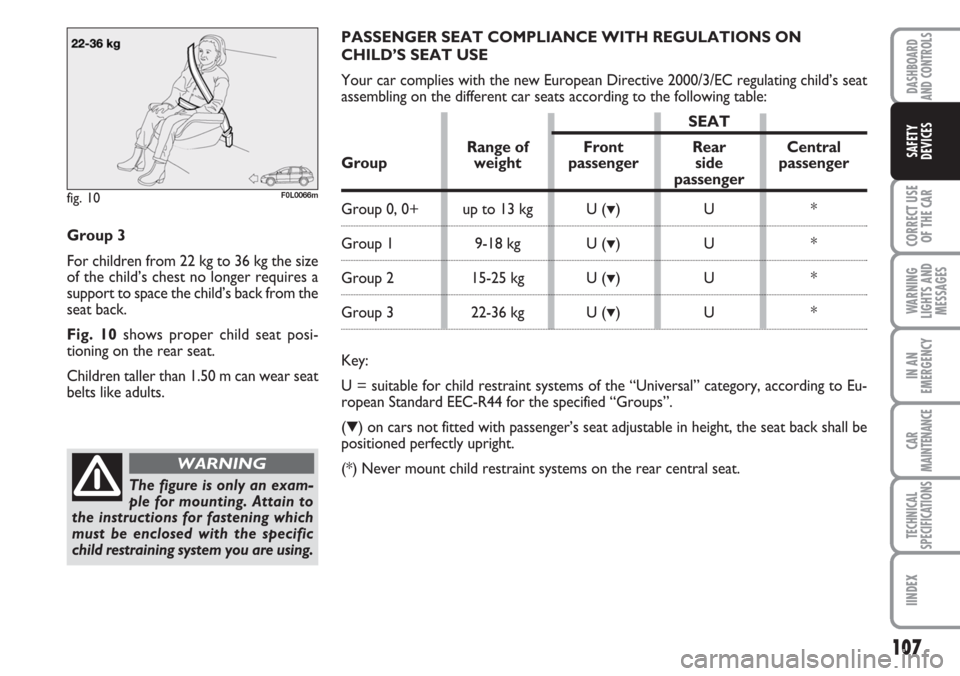
107
CORRECT USE
OF THE CAR
WARNING
LIGHTS AND
MESSAGES
IN AN
EMERGENCY
CAR
MAINTENANCE
TECHNICAL
SPECIFICATIONS
IINDEX
DASHBOARD
AND CONTROLS
SAFETY
DEVICES
Group 3
For children from 22 kg to 36 kg the size
of the child’s chest no longer requires a
support to space the child’s back from the
seat back.
Fig. 10shows proper child seat posi-
tioning on the rear seat.
Children taller than 1.50 m can wear seat
belts like adults.
fig. 10F0L0066m
The figure is only an exam-
ple for mounting. Attain to
the instructions for fastening which
must be enclosed with the specific
child restraining system you are using.
WARNING
PASSENGER SEAT COMPLIANCE WITH REGULATIONS ON
CHILD’S SEAT USE
Your car complies with the new European Directive 2000/3/EC regulating child’s seat
assembling on the different car seats according to the following table:
SEAT
Range of Front Rear Central
Group weight passenger side passenger
passenger
Group 0, 0+ up to 13 kg U (▼)U *
Group 1 9-18 kg U (▼)U *
Group 2 15-25 kg U (▼)U *
Group 3 22-36 kg U (▼)U *
Key:
U = suitable for child restraint systems of the “Universal” category, according to Eu-
ropean Standard EEC-R44 for the specified “Groups”.
(
▼) on cars not fitted with passenger’s seat adjustable in height, the seat back shall be
positioned perfectly upright.
(*) Never mount child restraint systems on the rear central seat.
Page 108 of 240
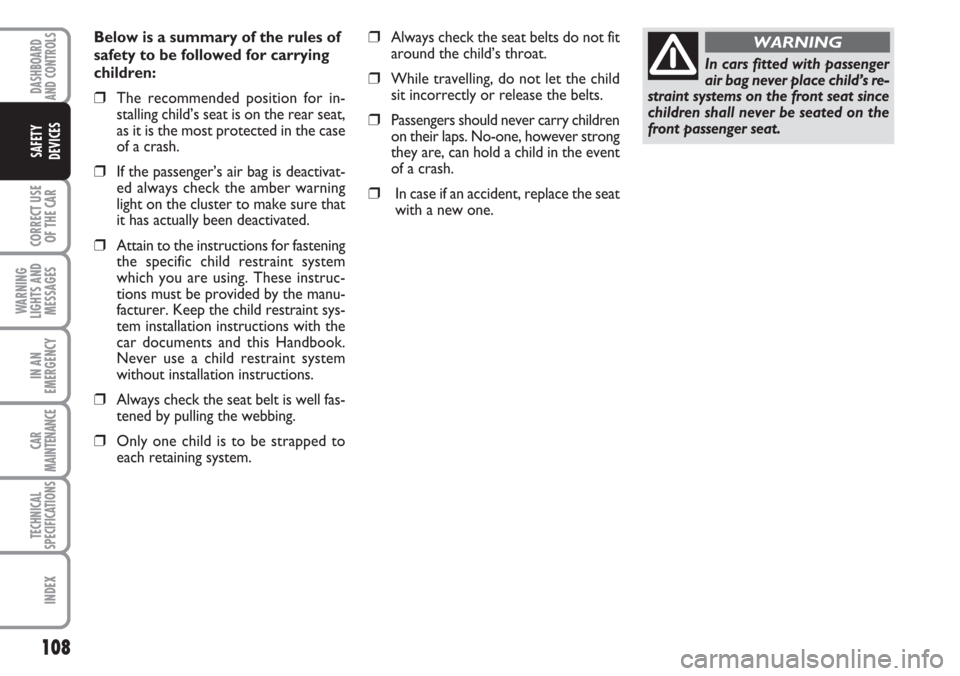
108
CORRECT USE
OF THE CAR
WARNING
LIGHTS AND
MESSAGES
IN AN
EMERGENCY
CAR
MAINTENANCE
TECHNICAL
SPECIFICATIONS
INDEX
DASHBOARD
AND CONTROLS
SAFETY
DEVICES
Below is a summary of the rules of
safety to be followed for carrying
children:
❒The recommended position for in-
stalling child’s seat is on the rear seat,
as it is the most protected in the case
of a crash.
❒If the passenger’s air bag is deactivat-
ed always check the amber warning
light on the cluster to make sure that
it has actually been deactivated.
❒Attain to the instructions for fastening
the specific child restraint system
which you are using. These instruc-
tions must be provided by the manu-
facturer. Keep the child restraint sys-
tem installation instructions with the
car documents and this Handbook.
Never use a child restraint system
without installation instructions.
❒Always check the seat belt is well fas-
tened by pulling the webbing.
❒Only one child is to be strapped to
each retaining system.
❒Always check the seat belts do not fit
around the child’s throat.
❒While travelling, do not let the child
sit incorrectly or release the belts.
❒Passengers should never carry children
on their laps. No-one, however strong
they are, can hold a child in the event
of a crash.
❒In case if an accident, replace the seat
with a new one.
In cars fitted with passenger
air bag never place child’s re-
straint systems on the front seat since
children shall never be seated on the
front passenger seat.
WARNING
Page 109 of 240
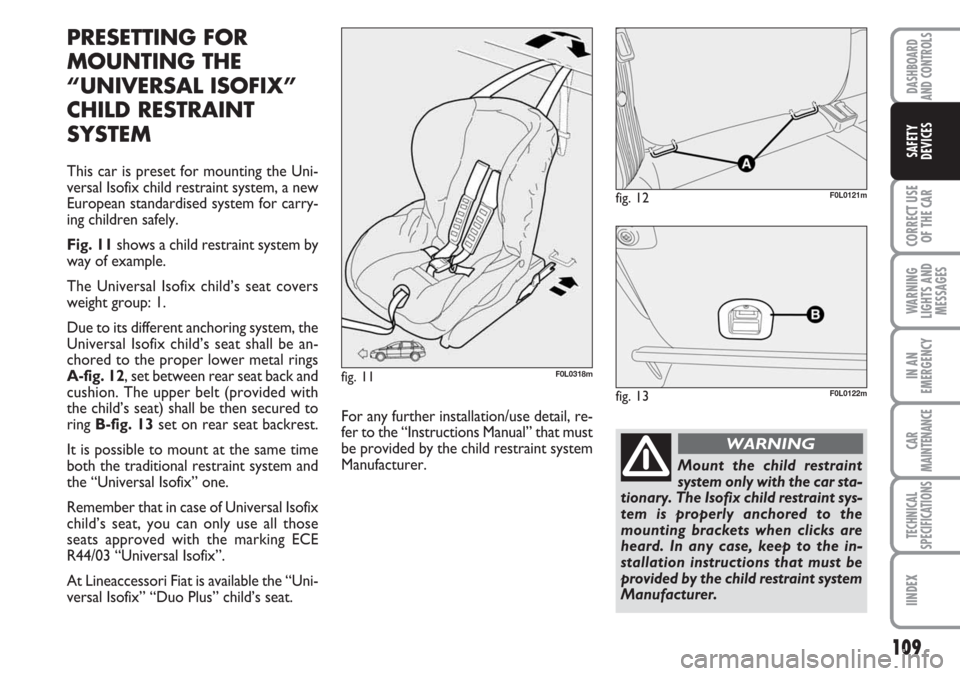
109
CORRECT USE
OF THE CAR
WARNING
LIGHTS AND
MESSAGES
IN AN
EMERGENCY
CAR
MAINTENANCE
TECHNICAL
SPECIFICATIONS
IINDEX
DASHBOARD
AND CONTROLS
SAFETY
DEVICES
PRESETTING FOR
MOUNTING THE
“UNIVERSAL ISOFIX”
CHILD RESTRAINT
SYSTEM
This car is preset for mounting the Uni-
versal Isofix child restraint system, a new
European standardised system for carry-
ing children safely.
Fig. 11shows a child restraint system by
way of example.
The Universal Isofix child’s seat covers
weight group: 1.
Due to its different anchoring system, the
Universal Isofix child’s seat shall be an-
chored to the proper lower metal rings
A-fig. 12, set between rear seat back and
cushion. The upper belt (provided with
the child’s seat) shall be then secured to
ring B-fig. 13set on rear seat backrest.
It is possible to mount at the same time
both the traditional restraint system and
the “Universal Isofix” one.
Remember that in case of Universal Isofix
child’s seat, you can only use all those
seats approved with the marking ECE
R44/03 “Universal Isofix”.
At Lineaccessori Fiat is available the “Uni-
versal Isofix” “Duo Plus” child’s seat.For any further installation/use detail, re-
fer to the “Instructions Manual” that must
be provided by the child restraint system
Manufacturer.
fig. 11F0L0318m
fig. 12F0L0121m
Mount the child restraint
system only with the car sta-
tionary. The Isofix child restraint sys-
tem is properly anchored to the
mounting brackets when clicks are
heard. In any case, keep to the in-
stallation instructions that must be
provided by the child restraint system
Manufacturer.
WARNING
fig. 13F0L0122m
Page 110 of 240

FRONT AND SIDE AIR
BAGS
The car is fitted with front air bags for the
driver, for the passenger and with driver’s
knees air bag (where provided).
The front driver / passenger air bags and
the driver’s knees air bag (where provid-
ed) have been designed to protect the oc-
cupants in the event of head-on crashes of
medium-high severity, by placing the cush-
ion between the occupant and the steer-
ing wheel or dashboard.
Front air bags are designed to protect
car’s occupants in front crashes and there-
fore non-activation in other types of col-
lisions (side collisions, rear shunts, roll-
overs, etc.) is not a system malfunction.
In case of crash, an electronic control unit,
when required, triggers the inflation of the
cushion. The cushion immediately inflates,
placing itself as a protection between the
body of the front occupants and the struc-
ture that could cause injuries. Immediate-
ly after, the cushion deflates.
The front driver / passenger air bags and
the driver’s knees air bag (where provid-
ed) are not a replacement of but comple-
mentary to the use of belts, which should
always be worn, as specified by law in Eu-
rope and most non European countries.
110
CORRECT USE
OF THE CAR
WARNING
LIGHTS AND
MESSAGES
IN AN
EMERGENCY
CAR
MAINTENANCE
TECHNICAL
SPECIFICATIONS
INDEX
DASHBOARD
AND CONTROLS
SAFETY
DEVICES
PASSENGER SEAT COMPLIANCE WITH REGULATIONS ON
UNIVERSAL ISOFIX CHILD’S SEAT USE
The table below, according to ECE 16 European Directive, shows the different instal-
lation possibilities of Universal Isofix restraint systems on seats fitted with Isofix fas-
teners.
Range of weight Child’s seat Isofix Isofix positionorientation class side rear
Group 0 to 10 kg
Group 0+ to 13 kg
Group I - 9
to 18 kg
IUF: suitable for Isofix child restraint systems to be set facing forwards, universal class
(fitted with third upper fastener), approved for the weight group.
IL: suitable for Isofix TYPE child restraint systems, specific and approved for this type
of car. The child’s seat can be installed by moving forward the front seat.
Facing backwards
Facing backwards
Facing backwards
Facing backwards
Facing backwards
Facing backwards
Facing forwards
Facing forwards
Facing forwardsE
E
D
C
D
C
B
B1
AIL
IL
IL
IL
IL
IL
IUF
IUF
IUF
Page 111 of 240
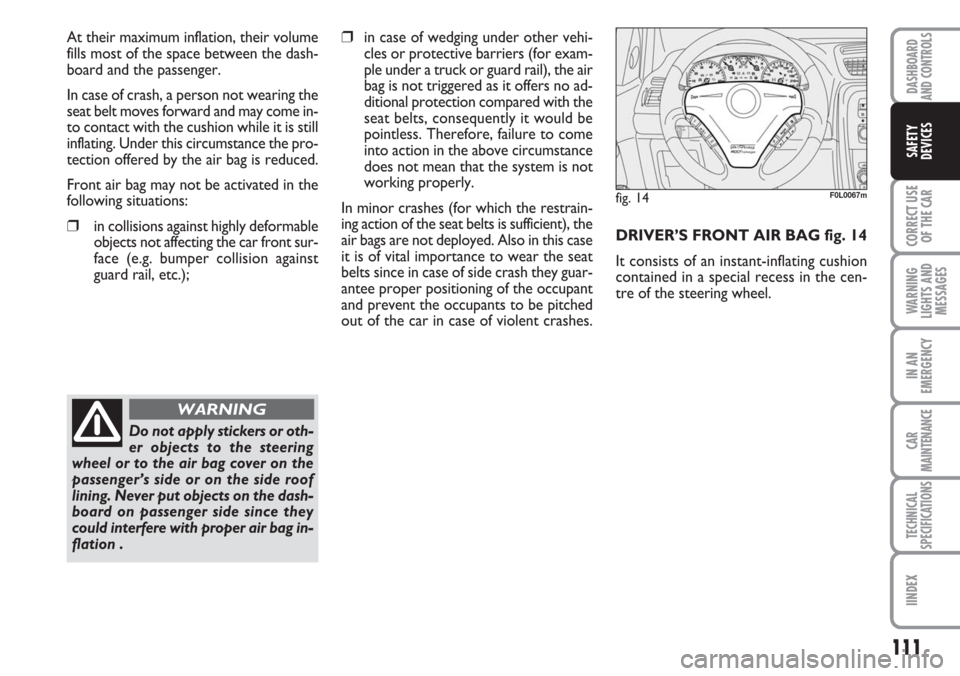
111
CORRECT USE
OF THE CAR
WARNING
LIGHTS AND
MESSAGES
IN AN
EMERGENCY
CAR
MAINTENANCE
TECHNICAL
SPECIFICATIONS
IINDEX
DASHBOARD
AND CONTROLS
SAFETY
DEVICES
At their maximum inflation, their volume
fills most of the space between the dash-
board and the passenger.
In case of crash, a person not wearing the
seat belt moves forward and may come in-
to contact with the cushion while it is still
inflating. Under this circumstance the pro-
tection offered by the air bag is reduced.
Front air bag may not be activated in the
following situations:
❒in collisions against highly deformable
objects not affecting the car front sur-
face (e.g. bumper collision against
guard rail, etc.);
❒in case of wedging under other vehi-
cles or protective barriers (for exam-
ple under a truck or guard rail), the air
bag is not triggered as it offers no ad-
ditional protection compared with the
seat belts, consequently it would be
pointless. Therefore, failure to come
into action in the above circumstance
does not mean that the system is not
working properly.
In minor crashes (for which the restrain-
ing action of the seat belts is sufficient), the
air bags are not deployed. Also in this case
it is of vital importance to wear the seat
belts since in case of side crash they guar-
antee proper positioning of the occupant
and prevent the occupants to be pitched
out of the car in case of violent crashes.
Do not apply stickers or oth-
er objects to the steering
wheel or to the air bag cover on the
passenger’s side or on the side roof
lining. Never put objects on the dash-
board on passenger side since they
could interfere with proper air bag in-
flation .
WARNING
DRIVER’S FRONT AIR BAG fig. 14
It consists of an instant-inflating cushion
contained in a special recess in the cen-
tre of the steering wheel.
fig. 14F0L0067m
Page 112 of 240
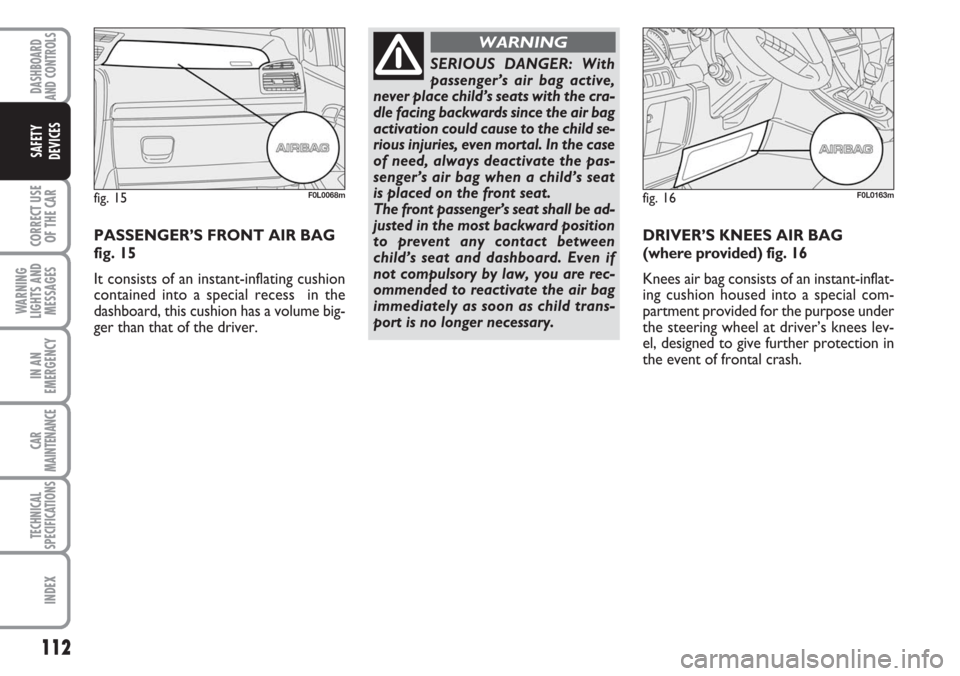
112
CORRECT USE
OF THE CAR
WARNING
LIGHTS AND
MESSAGES
IN AN
EMERGENCY
CAR
MAINTENANCE
TECHNICAL
SPECIFICATIONS
INDEX
DASHBOARD
AND CONTROLS
SAFETY
DEVICES
PASSENGER’S FRONT AIR BAG
fig. 15
It consists of an instant-inflating cushion
contained into a special recess in the
dashboard, this cushion has a volume big-
ger than that of the driver. DRIVER’S KNEES AIR BAG
(where provided) fig. 16
Knees air bag consists of an instant-inflat-
ing cushion housed into a special com-
partment provided for the purpose under
the steering wheel at driver’s knees lev-
el, designed to give further protection in
the event of frontal crash.
SERIOUS DANGER: With
passenger’s air bag active,
never place child’s seats with the cra-
dle facing backwards since the air bag
activation could cause to the child se-
rious injuries, even mortal. In the case
of need, always deactivate the pas-
senger’s air bag when a child’s seat
is placed on the front seat.
The front passenger’s seat shall be ad-
justed in the most backward position
to prevent any contact between
child’s seat and dashboard. Even if
not compulsory by law, you are rec-
ommended to reactivate the air bag
immediately as soon as child trans-
port is no longer necessary.
WARNING
fig. 15F0L0068mfig. 16F0L0163m
Page 113 of 240
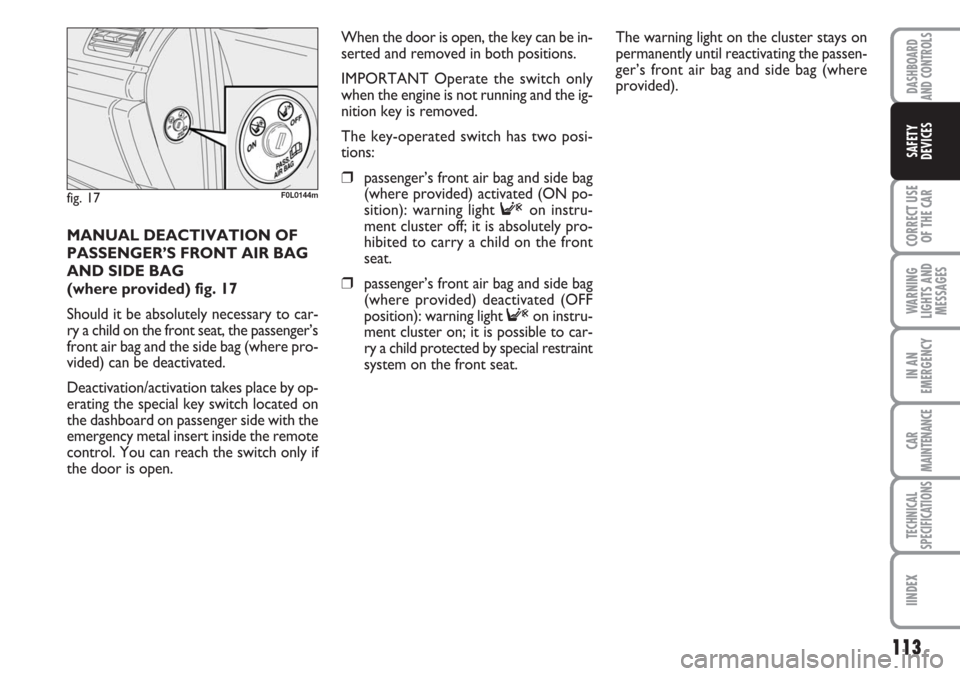
113
CORRECT USE
OF THE CAR
WARNING
LIGHTS AND
MESSAGES
IN AN
EMERGENCY
CAR
MAINTENANCE
TECHNICAL
SPECIFICATIONS
IINDEX
DASHBOARD
AND CONTROLS
SAFETY
DEVICES
MANUAL DEACTIVATION OF
PASSENGER’S FRONT AIR BAG
AND SIDE BAG
(where provided) fig. 17
Should it be absolutely necessary to car-
ry a child on the front seat, the passenger’s
front air bag and the side bag (where pro-
vided) can be deactivated.
Deactivation/activation takes place by op-
erating the special key switch located on
the dashboard on passenger side with the
emergency metal insert inside the remote
control. You can reach the switch only if
the door is open.When the door is open, the key can be in-
serted and removed in both positions.
IMPORTANT Operate the switch only
when the engine is not running and the ig-
nition key is removed.
The key-operated switch has two posi-
tions:
❒passenger’s front air bag and side bag
(where provided) activated (ON po-
sition): warning light
Fon instru-
ment cluster off; it is absolutely pro-
hibited to carry a child on the front
seat.
❒passenger’s front air bag and side bag
(where provided) deactivated (OFF
position): warning light
Fon instru-
ment cluster on; it is possible to car-
ry a child protected by special restraint
system on the front seat.
fig. 17F0L0144m
The warning light on the cluster stays on
permanently until reactivating the passen-
ger’s front air bag and side bag (where
provided).